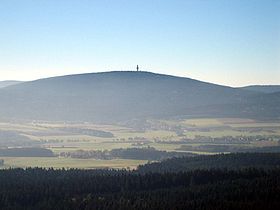Schneeberg (Fichtelgebirge)
| Schneeberg | |
|---|---|

The Schneeberg in October 2006
|
|
| Highest point | |
| Elevation | 1,051 m (3,448 ft) |
| Prominence | 474 metres (1,555 ft) |
| Coordinates | 50°03′N 11°51′E / 50.05°N 11.85°ECoordinates: 50°03′N 11°51′E / 50.05°N 11.85°E |
| Geography | |
| Location | Bavaria, Germany |
| Parent range | Fichtelgebirge |
At 1,051 m above sea level (NN), the Schneeberg is the highest mountain in the Fichtelgebirge, a mountain range in Upper Franconia in northeast Bavaria, Germany. It can be readily identified from a distance by its squat tower - a relic of the Cold War. The summit comprises a jumble of granite rocks and a rock pillar (Felsburg) on which the Backöfele observation tower stands and is still dominated by the relics of military installations including its Cold War listening post.
The name Schneeberg may be derived from snede ("border"). However, it is more likely that the name comes from Schnee ("snow") and the fact that the mountain is snow-capped for long periods of time.
The group of rocks at the highest point on the mountain is called Backöfele ("baking oven"), after which the observation tower was named. In the Thirty Years' War, folk from the surrounding village are supposed to have fled to this place where they baked their bread.
The mountain has always had great strategic significance due to its commanding field of view. In 1498 Captain Kunz von Wirsberg, captain of the Gebürg, was assigned by the margrave in Bayreuth to establish a warning system. As a result he set up a network of observation posts on various mountains in the Fichtelgebirge that in time of danger had to send beacon or smoke signals to the neighbouring posts. The Schneeberg was one of these posts. In 1520 the villagers of Weißenstadt had to establish a permanent sentry position here. In 1713 the ruins of this post could still be seen.
In 1879 the Fichtelgebirge branch of the German-Austrian Alpine Club (predecessor of the Fichtelgebirge Club or Fichtelgebirgsverein) built the first simple platform on the rock summit; at the same time a rude stone hut was erected. In 1904 a log cabin followed and in 1926 the Weißenstadt group of the Fichtelgebirge Club built the observation tower Backöfele from oak logs.
In 1938 the Luftwaffe had a 35 metre high wooden tower built on the mountain, the purpose of which was kept "secret". In 1942 it was razed for "unexplained reasons". On 14 November 1951 US Forces requisitioned part of the summit and erected various buildings and steel structures for antennas and parabolic mirrors. In 1961 the German Armed Forces (the Bundeswehr) took over the area to the north of the summit and, in 1967, communication sector (Fernmeldesektor) "E" took up its surveillance role in a new tower. The top of the mountain was a military out-of-bounds area and the Backöfele was now "behind the wire". Following the easing of military tension in Europe in the early 1990s, the US Forces left the Schneeberg on 30 April 1992 and, on 31 March 1993, the Bundeswehr closed its military surveillance mission. The last soldier left the Schneeberg air defence site (Luftverteidigungsstellung Schneeberg) on 30 June 1994 and the real estate was transferred to the Federal Finance Department (Bundesvermögensverwaltung). The former Bundeswehr tower was rented to the firm of Mannesmann (now Vodafone) for mobile phone use.
...
Wikipedia
